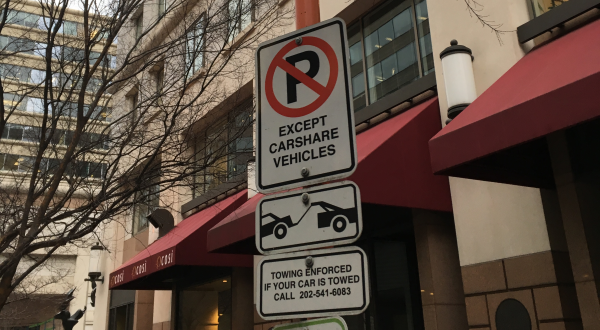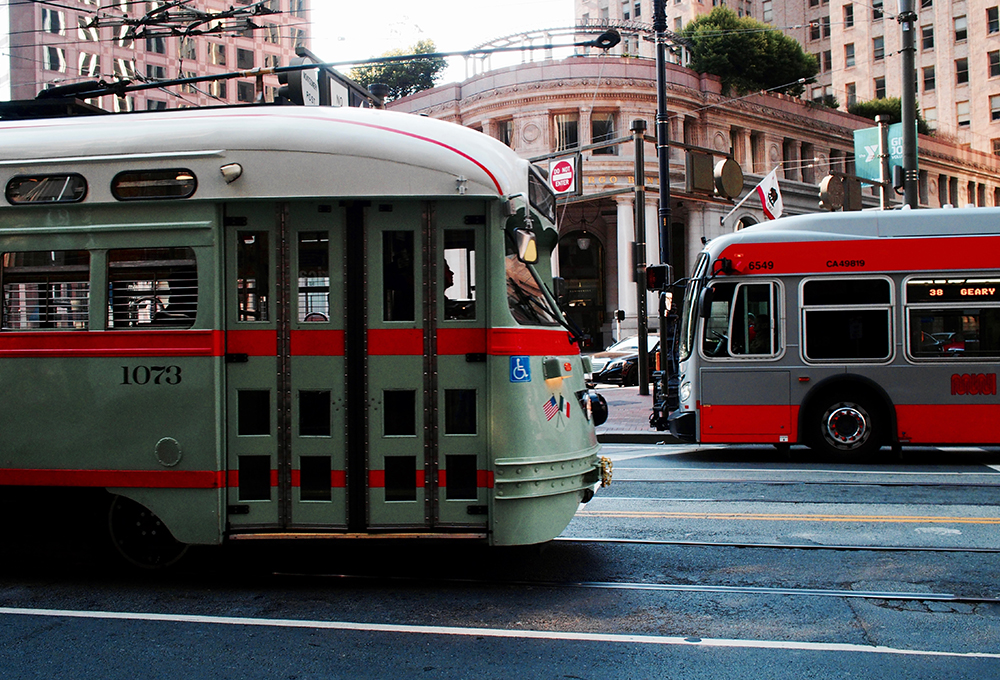Jump to section
Carsharing
With carsharing platforms enabling people to drive without needing a personal vehicle, how will infrastructure oriented around vehicle ownership shift?
Carsharing refers to any type of sharing service that involves the usage of a single vehicle by several different parties. It is distinct from transportation services offered by transportation network companies (TNCs) in that these vehicles—while they may be privately owned by one or more of the involved parties—are not part of an externally operated transportation network. Most vehicle sharing programs are short-term, membership based self-service car access systems with a network of vehicles for which members pay based on time used, distance travelled, or both. Carsharing can include any sort of vehicle sharing model, including traditional carsharing and timeshare/shared-lease services, typically accessed through smartphone apps or other digital methods. Well-known contemporary examples of carsharing services include Zipcar, Turo, Getaround, and Enterprise CarShare.
Variables to consider
Station-Based/Roundtrip, Peer-to-Peer, Point-to-Point & Fractional Ownership
The early days of North American vehicle sharing grew out of the “station car” idea in the late 1990s where vehicles were made available at passenger rail stations, and by 1999 there were nine carsharing organizations in existence—five in Canada and four in the U.S. For more than 15 years, carsharing was run almost exclusively as roundtrip carsharing, requiring members to pick up and return a vehicle from the same location. However, the carsharing industry has expanded over the past decade, largely due to advancements in smartphone technology, and has experienced an evolution in the types of operational models available. Newer carsharing forms include one-way/point-to-point carsharing, peer-to-peer carsharing where individuals access a privately owned vehicle fleet through a third party, and fractional ownership where individuals co-lease a vehicle. While many carsharing models have proven unprofitable and have seen dramatic closures, peer-to-peer options such as the GetAround and Turo platforms continue to grow.
Free-Floating Carshare
Free-floating carshare, which enables users to pick up a vehicle and end the trip anywhere on permitted streets or company-marked parking locations, had grown pre-pandemic. Daimler’s Car2go—later merged with BMW’s DriveNow to form the joint ShareNow service—was one of the first players to try out free-floating carsharing, and by 2018, it had grown to over 2 million members across North America, Europe, and Asia at one point having 14,000 vehicles in 30 locations worldwide. Symbolic of the difficulties faced in the free-floating carshare industry, ShareNow has dramatically reduced operations and now only operates in Europe. Traditional automakers such as BMW entered the U.S. and European markets with carsharing models such as DriveNow and ReachNow, but have also closed operations since then.

Innovation Drivers
Carsharing requires less of a commitment than using personal vehicles. Considerations such as short-term parking when making points-to-point trips can be mitigated, while long-term parking, vehicle storage, and maintenance can be avoided by using carsharing services instead of an owned personal vehicle. Personal vehicle owners can also benefit from carsharing services while travelling without their personal vehicles, such as by using carsharing services to supplement or replace other forms of transportation including taxis/shuttles, TNCs, and rental cars. In doing so, carsharing can make it more feasible to travel without needing to bring personal vehicles on long-distance trips for the purposes of maintaining mobility once at the destination.
Carsharing can be considerably less expensive than personal vehicle ownership, particularly for people with mobility needs that don’t include regular driving. Compared to using a personal vehicle for most transportation needs, carsharing services remove maintenance costs, fees, taxes, long-term insurance, and the need to pay for long-term parking. They also remove the need to purchase a personal vehicle in the first place, providing mobility options to individuals who can’t afford the upfront and ongoing expenses of personal vehicle ownership.
Carsharing can provide a more efficient use of resources when compared to personal vehicle ownership and usage, both in terms of resources necessary to create the vehicles and in terms of resources necessary to maintain and store them. With sufficient market penetration, shared vehicles could significantly reduce the number of vehicles necessary to service an area, resulting in fewer vehicles being manufactured and fewer vehicles on the road or taking up parking space. In turn, this could result in fewer resources being allocated to manufacturing facilities, maintenance facilities, parking structures, etc.

Eric Fischer via Flickr / (CC BY 2.0)
Barriers
Carsharing services are not always cost-effective when compared to personal vehicle ownership. They typically have lower fixed costs than personal vehicle ownership, with flat membership fees rarely exceeding $100 USD annually, but often much higher variable costs based on miles travelled, time used, or both. For people who drive more than 6,000 miles/10,000 kilometers a year, personal vehicle ownership will be cheaper in most circumstances. Costs are particularly high for services that require roundtrips as charges include the time spent at a destination.
Carsharing services can be inaccessible or unavailable to some people. Many carsharing services rely on either smartphone apps or online interfaces to reserve, pay for, and access shared vehicles, barring people without consistent internet access or mobile data plans from accessing the service. Additionally, fleet-based carsharing services require a pickup and dropoff system to be in place, as well as a method for maintaining and servicing fleet vehicles. In some areas, particularly rural areas, the infrastructure necessary to support carsharing services is not always present, such as easily accessible stations or reliable internet and data coverage.
Carsharing - particularly one-way and free floating carsharing - is still an unproven business model. While one-way and free floating car sharing saw dramatic growth before 2020, businesses using those models saw dramatic reduction and closures after that date. Difficulties in profitability and difficulties due to COVID led to widespread reduction of services. Peer-to-peer services, conversely, have seen substantial growth.
Key players
Rental car companies such as Avis, Hertz, and Enterprise operate carsharing services, including some of the largest such as Zipcar (Avis) and CarShare (Enterprise). These services are typically fleet-based, and sometimes use vehicles previously allocated for traditional rental services.
Automobile manufacturers such as BMW and Daimler-AG are also operating their own carsharing services such as ShareNow. As with rental car companies, these services were typically fleet-based, with shared vehicles provided by the parent automobile manufacturer. Many of these services have now shut down.
Independent carsharing organizations also exist, with companies such as Getaround and Turo exclusively oriented around operating carsharing services. In contrast to services operated by rental car companies or automobile manufacturers, these companies typically operate on a peer-to-peer model, connecting private vehicle owners willing to rent out their vehicles to prospective renters.
Use case examples
People are using carsharing services when personal vehicle ownership isn’t feasible or necessary. People living in dense urban areas with limited to no long-term parking, for example, are using carsharing services as an alternative to trying to find a long-term parking solution for a personal vehicle. This can also apply to people who cannot purchase a personal vehicle of their own for other reasons as well, such as lease restrictions or lack of access to credit and banking services necessary for vehicle ownership. People who only need to drive a vehicle irregularly or for special occasions are also using carsharing services to meet their transportation needs.
People are using carsharing when personal vehicle ownership would be cost inefficient or cost prohibitive. People in situations where the cost of storing and maintaining a personal vehicle outweighs the benefit they would get from personal vehicle ownership are using carsharing services as a cost-effective alternative when making trips that require driving. Similarly, people who simply cannot afford the upfront and ongoing expenses of personal vehicle ownership in the first place are using carsharing services on an as-needed basis.
People are using carsharing services to reduce their reliance on their personal vehicles when travelling. Rather than driving their own personal vehicles on long road trips or resorting to taxis/shuttles, ridehailing services, or rental cars after travelling to a destination, people are instead using carsharing services for on-demand mobility needs. This is particularly true of free-floating carsharing services such as ShareNow, as they can provide travellers with flexible self-service mobility options at a price point often much lower than those found among TNCs, taxis/shuttles, and conventional vehicle rentals.
Pilots & developments
1948 – Swiss housing cooperative Selbstfahrergemeinschaft, or “Sefage,” implements one of the first carshare programs. The project, while successful, is localized around Zürich and remains small.
1971 – A service called ProcoTip launches in Montpellier, France, which aims to provide a more widespread service than previous efforts such as Sefage. The service lasted two years before shutting down.
1974 – Witkar, one of the first fleet-based car sharing services is introduced, starting operations in Amsterdam. The Dutch service utilized distinctive electric vehicles operating on a station-based model, and remained in operation until 1986.
1983 – Two carshare systems launch in the United States. Both carshare systems, Purdue University’s Mobility Enterprise and Short-Term Auto Rental (STAR) in San Francisco, launch as short-term carshare experiments.
February 1998 - The first official carsharing program begins in the United States when CarSharing Portland launches in Portland, Oregon.
January 2000 - Flexcar and King County Metro collaborate to form possibly the first public-private carsharing partnership in the United States.
April 2000 - Zipcar launches as a membership-based car-sharing company in Cambridge, Massachusetts that built technology to enable real-time self-service reservations, car access, and billing.
June 2009 - Zipcar and Apple reveal the new Zipcar app, an app created in collaboration between the two companies to make it easier for users to reserve Zipcar vehicles.
September 2010 - Governor Schwarzenegger signs Assembly Bill 1971 into law, making California the first state to establish a regulatory framework for carsharing.
December 2010 - Car rental company Hertz creates their own carshare service, starting a trend for other car rental companies in the United States.
December 2012 - Enterprise creates their own carsharing service, Enterprise CarShare.
2015 - Carsharing membership in the United States declines four percent year-over-year, the first decline in US carsharing since its creation.
2015 - Despite declines in US carshare usage, business consulting firm Frost & Sullivan estimates there are 7 million careshare users worldwide in 2015, double the number of users in 2013.
December 2019 - SHARE NOW, a popular smartphone-enabled Car2Go carsharing service in North America and Europe, announces they will cease all operations in North America, London, Brussels, and Florence, effective February 29, 2020.
March 2020 - While COVID drastically reduces use of all shared mobility services, carsharing eventually increased as it provides a transportation option that avoids contact with other people.
Resources
Policies, Pilots, and approaches
Communication tools
See something that should be here that isn't? Have a suggestion to make?






